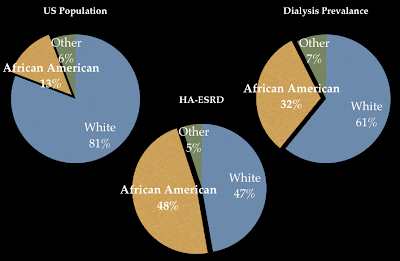I was listening to the Kidney International Podcast and they start interviewing (iTunes Link) Barry Freedman of Wake Forrest. He starts talking about the MYH9 gene. This tweaks my interest and I start paying attention, thinking to myself, "Is this gene making a comeback?" And then he starts talking about the the Nature Genetics papers from 2008. No mention of APOL1. I glance down at my iPhone, the podcast is from 2009. I was relieved that I hadn't missed a major U-turn. Listenning to the remainder on the podcast I can't help but smirk at the hyperbole.
His paper was on hypertension associated end-stage renal disease and its tight association with MYH9. He waxes on about how it is one of the most strongly associated genes in any common disease. He states that if you could remove the MYH9 risk variants from the African American population, 70% of the non-diabetic kidney disease would disappear. He states that MYH9 is responsible for initiating most kidney disease in African Americans and that hypertension is very unlikely to be an initiating factor in kidney disease.
If you are not familiar with the history of this wrong-turn, here is a brief overview:
- In October 2008, Jeff Kopp, using a new technology known as admixture-mapping linkage-disequilibrium genome scan found an association with FSGS and a variant in the a gene called MYH9. The same gene variant was also associated with HIVAN. This was hailed as a major break-through explaining the excess kidney disease burden found in African Americans.

- MYH9 had already been associated with a cohort of genetic conditions that all had glomerular pathology so the link seemed pathophysiologically sound.
- The nephrology research world became fascinated with this gene and for about a year tremendous resources were focussed on this gene.

- In July 2010, Science published data that showing that a different gene, APOL1, located close to MYH9 on the chromosome, was actually responsible for the high association of disease. Of note Barry Freedman is also an author of this paper.
- Being heterozygous for APOL1 is protective against the Trypanosoma parasites that cause African Sleeping sickness
- Trypanosoma brucei brucei infects many mammals but is unable to infect humans because human serum contains a complex, trypanosome lytic factor (TLF)
- Trypanosoma brucei rhodesiense and Trypanosoma gambiense evolved a defense against TLF and were able to infect humans.
- A single copy of APOL1 restores TLF and makes the carrier immune to sleeping sickness
- Two copies of the APOL1 predisposes the carrier to proteinuric kidney disease and HIVAN
- Balanced polymorphism
- APOL1 mutation is about 10,000 years old, but humans migrated to Europe 70,000 years ago, so Europeans, never shared in the mutation.
While it is hilarious to listen to the certainty of Dr. Freedman's proclamations, the incident also has a lesson for dealing with social media. Publishers, including bloggers, are constantly publishing information that expires. Facts become falsehoods and time reveals truths. However, what we have published remains. Leaving these mistakes, without editorial comment is a disservice to our readers. Even though what we wrote may be buried under dozens of posts, Google still indexes it and still sends readers to this material. Kidney International unfortunately never did another podcast, so when one subscribes to their podcast, this story is what is downloaded as "most recent."
Search and the permanence of internet means that we need to take responsibility for old content, in a way that wasn't necessary in the past.

